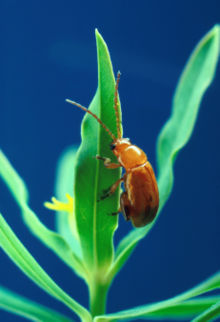Beetle
Template:Taxobox begin
Template:Taxobox image
Template:Taxobox begin placement
Template:Taxobox regnum entry
Template:Taxobox phylum entry
Template:Taxobox subphylum entry
Template:Taxobox classis entry
Template:Taxobox subclassis entry
Template:Taxobox infraclassis entry
Template:Taxobox superordo entry
Template:Taxobox ordo entry
Template:Taxobox end placement
Template:Taxobox section subdivision
Adephaga
Archostemata
Myxophaga
Polyphaga
many subgroups:
see Subgroups of the order Coleoptera
Template:Taxobox end
Beetles (order Coleoptera) are one of the main groups of insects. The order has more species in it than any other order in the entire animal kingdom. 40% of all insect species are beetles (about 350,000 species), and new species are regularly discovered.
The forewings of beetles are transformed into hard shells, called elytra. These elytra form an armour protecting the abdomen and the sensitive hindwings. The forewings are not used (at least not actively flapped) in flying, but they must (in most species) be raised in order to move the hindwings. After landing the hindwings are folded below the elytra. Most beetles can fly, but few reach the dexterity of some other groups, e.g. flies, and many species only fly if absolutely necessary. Some beetles have elytra that have grown together and cannot fly at all; a few have lost their wings altogether.
Some beetle larvae (young) are leaf miners.
Beetles can be found in almost all biomes, but are not known to occur in the sea or in the polar regions.
Beetles are endopterygotes with complete metamorphosis. The larva of a beetle is called a grub.
When J. B. S. Haldane, a British geneticist, was asked what his studies of nature revealed about God, he replied, "An inordinate fondness for beetles."
The study of beetles is called coleopterology, and its practitioners coleopterists. See list of notable coleopterists.

Notable types
Well-known types of beetles include:
- bark beetle
- bess beetle
- click beetle
- Colorado potato beetle
- firefly
- ground beetle
- Japanese beetle
- ladybird beetle (or ladybug or lady beetle)
- scarab beetle
- Spanish fly (actually a beetle)
- stag beetle
- water beetle
- weevil
- Wood-boring beetles (woodworm)
Some types of beetles are less well-known, but are problems in some areas:




Subgroups
The extraordinary number of beetle species poses special problems for classification, with some families consisting of thousands of species and needing further division into subfamilies and tribes.
See Subgroups of the order Coleoptera for a complete list.
Reference
- Ross H. Arnett, Jr. and Michael C. Thomas, American Beetles (CRC Press, 2001-2)
Journals
- The Coleopterist (UK)
External links
- http://www.coleopterist.org
- http://www.koleopterologie.de/gallery - Gallery of middle-European beetles
- http://www.goldenphoenixexotica.com - Information on Beetles and other invertebrates
